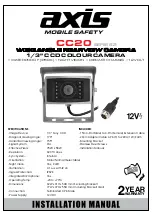
short distance. If it doesn't, you know
that the diaphragm-control magnet M2
and the diaphragm-control capacitor C5
are both doing their jobs.
But you may find that it's easier to check
the operation if you can actually see the ar
mature of M2. Just pull aside the battery
compartment by removing its tw o screws,
Fig. 16. You can now see the M2 assembly
through a clearance cutout in the bottom
of the body casting, Fig. 17.
To check M2, hold open the shutter at
the bulb setting and disengage the M1 ar
mature as previously described.
Re
member, pushing the M1 armature away
from its core opens switch S7. S7 must be
open in order for transistor T13, Fig. 14, to
turn on.
Now short between the collector and
the emitter of T5, Fig. 15. You should see
the armature jum p toward the front of the
camera. If the armature jumps away from
the core, both M2 and C5 must be good.
You might then suspect transistors T5
and T13, Fig. 14. W hile still holding open
the shutter on bulb w ith S7 open, try
shorting between ground and the collec
tor of T13, Fig. 15. Once again you should
see the M2 armature jump away from its
core. But, if the armature fails to move,
transistor T5 must be defective.
If the armature does move, the problem
may be w ith T13 or w ith the signal from
the aperture-control comparator. You can
make one more shorting test to check
T13. Again hold open the shutter on bulb
and open S7. Then short between the
base of T13 and ground. If the armature
jumps away from the core, there's no
problem w ith T13. The problem must be
in the aperture-control circuit. You'll have
to remove the top cover to reach the IC
that provides the turn-on signal.
Let's now consider the other possibility
— the M2 armature does not release
when you short across transistor T5. You
might first suspect an open coil. To check
the coil continuity, measure the resis
tance between the brown wire, Fig. 15,
and ground. You should measure the
resistance of the coil — around 15 ohms.
Also suspect the diaphragm-control
magnet M2 if the diaphragm fails to stop
down. Such a malfunction could indicate
a problem either w ith the diaphragm-
control magnet or w ith the circuit. But it's
usually fairly easy to pinpoint the problem
area — just check the operation at the d if
ferent modes. If the diaphragm fails to
stop down at all three modes — A, M,
and S — suspect the diaphragm-control
magnet M2. However, if the problem only
occurs at the S mode, suspect the circuit.
When the diaphragm fails to stop
down, the diaphragm-control magnet
isn’t holding its armature. The armature
th e n im m e d ia te ly arrests th e the
diaphragm-closing lever. If the problem
occurs at all three modes, try cleaning the
contact surfaces of the armature and of
the permanent magnet, Fig. 17. Dirt can
prevent the core from magnetically hold
ing the armature.
If cleaning doesn't do the job, the per
manent magnet may be defective. Try
pushing the armature of M2 away from
the core. Fig. 17; you should be able to
feel the magnetic attraction. A defective
permanent magnet requires that you
replace M2, a job which means pulling the
front-plate/m irror-cage assembly.
Now consider the other possibility — the
problem only occurs at the S mode. The
symptom indicates that the diaphragm-
control circuit gets the release signal as
soon as switch S7 opens. You can spot the
problem by using the technique we describ
ed earlier at the bulb setting. Watch the ar
mature of M2 as you push the M1 armature
toward the front of the camera, Fig. 16. If
the M2 armature now jumps away from the
core, the circuit is sending the release signal
right away.
To verify the malfunction, you might
try operating the camera at the S mode
while you're shorting across the base and
emitter of transistor T13, Fig. 15. Your
short should keep transistor T13 shut off.
And, as a result, the armature of M2
should remain against the core. If the ar
mature still jumps away from its core, the
problem is on the circuit board at the bot
tom of the camera — most likely, a
shorted transistor. But if the armature re
mains against the core, the problem is in
the circuit that sends the signal to T13.
You must then remove the front-plate/
mirror-cage assembly. The problem could
be as simple as the violet wire's shorting
to ground; or a switch or IC may be
defective.
S U M M A R Y OF TROUBLESHOOTING AT BOTTOM OF CAMERA
As you can see, it's possible to check most of the electromagnetic diaphragm-
closing and release systems from the bottom of the camera. W hat if the possi
bilities we've discussed don 't get you to the problem? You'll then have to go fu r
ther. For example, if the mirror w o n 't release electromagnetically, the problem
could be in the release switch. You can check the remaining switches just by
removing the top cover. The follow ing chart summarizes the troubleshooting
covered so far.
SYMPTOM
Shutter w o n 't release, LEDs do not
operate
POSSIBLE CAUSE
No battery power to lower circuit board
— check for 3V at red wire, Fig. 13. No
voltage — check battery compart.
Shutter w o n 't release, LEDs operate
Diaphragm fails to stop down, LEDs
operate
All modes
S mode only
Diaphragm always stops down fully,
"o v e r" LED remains on
Release switch (remove top cover to
check)
Coil M1 open
Capacitor C6
Transistor T6
Switch S I, poor contact
Solder connections to lower circuit
board (red, black, yellow)
No release signal from comparator
Combination magnet M2, armature dirty
or permanent magnet defective
Violet wire shorted to ground
Transistor T13
Comparator always presents release
signal to T13
Solder connections to lower circuit
board (purple, w hite brown, black)
Film-speed resistor open (remove top
cover to check)









































